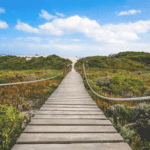De Hoop Nature Reserve
The De Hoop Nature Reserve is situated on the world-renowned Garden and Whale Routes. It is 340 square kilometers in area with a 70-kilometre stretch of coastline. You can discover a wealth of marine, bird, animal, and rare plant species. The reserve offers a great outdoor experience with the sea, dunes, fynbos, and mountains. You will also spot some roaming wildlife like the Cape Mountain zebra and eland to name a few.
. This Provincial Nature Reserve of 750 ha is a Ramsar site. Within the reserve is a coastal lake where water levels vary according to the season. Salinity varies too, this is due to dunes that form and block the course of the Sout River. It is important for many species of wintering and staging waterbirds. The native turtle, common in the 1960s, has since become rare but can be found here.
De Hoop Nature Reserve is one of the components of the “Cape Floral Region Protected Areas” World Heritage Site. This Marine Protected Area extends three nautical miles out to sea from the coastline of the nature reserve. It is one of the best land-based whale-watching areas in the world. The area is a very important nursery for this endangered mammal During June to November, Southern Right whales come very close to the shoreline.
De Hoop Nature Reserve
On the cliffs of Potberg Mountain is the Western Cape’s last surviving colony of endangered Cape vultures. Take a drive through endangered fynbos to the cliffs of Potberg Mountain near L’Agulhas. You can then hike ± 1 hour up to the Vulture Deck where you can watch the vultures swooping and soaring above..
Few other reserves offer such a complete outdoor experience as De Hoop does. Sea, sand dunes, the vlei, a floral kingdom of rare fynbos, diverse antelope, and the Potberg Mountains. Bird-watching enthusiasts can observe wading birds on the shores of the vlei. Hikers and cyclists can have close-up encounters with Bontebok, Cape Mountain Zebra, Eland, and Baboons.
During the high season, Koppie Alleen has a food trailer. De Hoop has a great restaurant at Die Opstal. You can also pack your own picnic basket which may be advisable if these outlets are not open. Other activities in the reserve include swimming, snorkelling, boat cruises, and mountain biking. There are several day walks and hikes, as well as the famous Whale Trail, a 6-day 5-night guided slackpacking hiking trail that starts in the mountains and ends on the coast.
Enquire at reception about these other activities:
- Guided Bird Walk
- Guided Marine Walk
- Eco Boat Cruise
- Vulture Experience
- Spa Treatments
- De Hoop is home to the extremely popular 5 day Whale Trail.
34°27’S 020°20’E
De Hoop mountain bike experiences TEL: 084 228 0414
info@overbergmtbevents.co.za
The land on which the De Hoop Nature Reserve is situated used to belong to the Dutch East India Company. A Dutchman, Frederick De Jager acquired the lease in 1739. After having spent time living in reed-thatched tents, a more permanent structure was built. This now forms part of the Opstal Manor House which is still intact 270 years later.
The first farm, 14500 hectares in size and called ‘The Hope’ with Melkkamer as the central point. The farm was inherited by De Jager’s son who sold it to Pieter Lourens Cloete in 1820.
In 1850 the farm was subdivided and Melkkamer was sold to Tieleman Myburgh who later sold it to John Henry Anderson. However, the land was expropriated in 1985 for a military testing site development.
The De Hoop Homestead was bought by Harry Wood in 1947. Communication across the vlei with The Melkkamer owner, Netta Anderson, had to be done using a loudhailer!
Eventually, De Hoop was sold to the Gardiner family in 1953. Unfortunately, the sheep stock was decimated when the flock was struck by ‘lamsiekte’ (sheep disease) forcing the Gardiners to sell to the government in 1956. The area was then proclaimed as a nature reserve.


